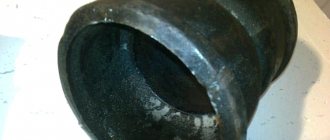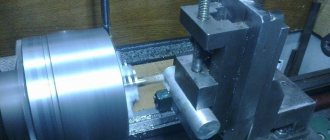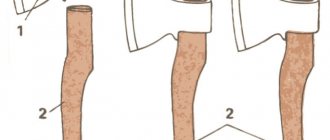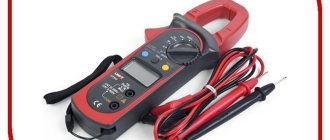Any motorist or just a home craftsman has a whole arsenal of various kinds of devices that make work easier. Assembly and disassembly of complex mechanisms and structures is accompanied by unscrewing the nuts. Some of them cannot be removed with a regular key due to their placement in hard-to-reach places. In such cases, they resort to the help of end modifications. They greatly simplify solving such problems. Having such a kit on hand, you can easily carry out almost any preventative and repair work on your car. The scope of use is not limited to transport; they are in demand when repairing furniture, plumbing fixtures and even household appliances.
What does it represent?
Part of a metal cylinder of a curved shape with a faceted internal working part. The number of edges varies from 6 to 12. The curved handle is always placed above the fastener. To perform specific tasks (shut-off valves), models with 4 or 3 faces are used. They are the same size as a screw nut.
They became in demand due to:
- the ability to unscrew a nut located in a hard-to-reach place;
- large contact area, removing bolts without multiple sides.
It is worth noting the fact that in such cases open-end wrenches are powerless. The cylinder is connected to a lever that drives the tool. There are models with double-sided design.
A set of socket wrenches is bulky and takes up a lot of space. A large amount of material is used in manufacturing and this has a negative impact on its cost. To reduce costs and increase consumer demand, the establishment has undergone significant changes. The production of tools with a set of interchangeable heads has begun. The kit included replaceable extensions, universal joints and other elements,
The base has a protective coating. Its character depends on the color. To obtain a black color, the instrument is oxidized in oil. To give it a white matte shade, it is galvanized (coated with a zinc compound). Chrome plating adds shine. Premium models are produced with anti-corrosion coating. To do this, they are finished with a special compound and polished.
Modifications with a ratchet deserve special mention. They are designed to work in confined spaces and minimal angles. The torque increases with a constant applied force. The number of teeth varies. The number increases as the degree of angle decreases. For models with 72 teeth, 5 are enough. With them, cramped space is no longer a problem.
Where are they used?
Socket wrenches come in a wide range and are classified as wrenches. They are indispensable when unscrewing and tightening nuts located in a small recess or with a damaged upper part. The monolithic base has a curved shape and ends with a hexagonal recess. The handle plays the role of a lever. The tool is put on the nut from the end. Unscrewing will require significant effort from the performer. The short part is used for twisting, and the long part for unscrewing. This helps remove a bolt with oxidized threads. A number of models in the bend received a special recess for protruding parts.
The key is used in almost all areas of life. This led to the appearance of many modifications. These include hinged, corner, cap, etc. They have won the greatest love among motorists. Removing spark plugs, securely fixing wheels and minor difficulties that arise during repair work. The latter include the inability to unscrew an old rusty bolt or nut. Such manipulations cannot be performed with conventional tools.
Advantages:
- increased area of interaction with the working element;
- working with damaged nuts and bolts;
- interaction in a limited space;
- ratchet for contact in confined spaces;
- socket heads can replace several similar wrenches. This was appreciated by professional craftsmen and home craftsmen;
- a variable number of faces in the socket heads contributes to the versatility of the tool;
- the tool can withstand hammer blows on the lever;
- Chrome vanadium steel has high strength and wear-resistant characteristics.
Flaws:
- increased load leads to breakage of the ratchet;
- universal socket wrenches with a four-profile head, limited in use as they are too large;
- hinge mounts for removable heads often break;
- the long, massive handle will cause inconvenience during storage and transportation;
- high cost of the set.
What are they?
The wide range of keys is determined by the area in which it is involved and the specifics of the tasks performed. Highlight:
- Double-sided. A universal solution that has won the love of the public. The handle is equipped with 2 recesses of a certain size. Models with removable heads are compatible with 8 profiles. Among the shortcomings, note the large nozzle. It makes it difficult to use in hard-to-reach places.
- L-shaped (angular). The length of the sides varies depending on the purpose. The edges of the handle are equipped with recesses of the same size. This is due to the nut placement options. If it is recessed deeply, use the long part, but due to the small size of the lever, more effort is applied to turn it. A closely placed part is removed with a minimum of effort due to the larger size of the lever. The number of edges varies from 6 to 12. The keys are created from alloy steel alloys and then coated with a protective layer, with a base of chrome and nickel.
- T-shaped. It consists of several parts: a hexagon and a crossbar placed perpendicularly. They are presented on the market with a monolithic and movable lever. During manipulations, forces are applied on both sides of the axis. In this case, the load is distributed evenly and the performer gets less tired. Shoulder length may be changed. The effort increases. Models designed to work with small joints received gates with a non-metallic surface. They are more convenient to use. The attachments can be removable or with a swivel joint.
- Cross-shaped (balloon). A car enthusiast's constant companion. Depending on the manufacturer, they may have an L or X-shape. The latter are equipped with 4 nozzles for quick selection of the appropriate size. In manufacturing, thick rods with appropriate metal attachments are used. The keys have a strong mechanical impact. Designed for unscrewing/tightening the nuts that secure a car wheel. They are in demand at tire centers and among car owners for urgent tire replacement on the road. For large vehicles, there are reinforced or power models.
- Articulated. The modification implies the presence of a part of the same name, which allows movement relative to each other in several planes. Relevant in places with limited space. The axis of rotation is placed at an angle relative to the working element. There are double and single modifications. They perform well when carrying out plumbing work and vehicle repairs. They effectively cope with tightening threads where the use of other types is not possible.
- With a ratchet. Does not require flipping to continue interaction with the nut. This made it possible to use the key in places with a limited rotation angle. The work is significantly accelerated, torque is added (the applied forces remain unchanged). The modifications differ in the number of teeth. To calculate the available angle, 360 is divided by the number installed. The main disadvantage of the band is that excessive physical impact will cause breakage.
- Tubular (I-shaped). Externally they are similar to a hollow cylinder, the ends of which are equipped with a hexagonal profile. Use is possible only with a special lever (knob), which is placed in a special through hole in the body of the key. The tube is made of special steel with a chromium-molybdenum composition. The protective coating is obtained by oxidation in oil and chrome plating. Depends on the manufacturer. Demanded by car enthusiasts when replacing spark plugs on internal combustion engines.
- With a cap head. Represented by a wrench and a set of removable socket heads. Depending on the manufacturer, the lever may have a ratchet that moves in one direction, or with a square end with a locking ball. The presence of a swivel joint provides an extension rod. The set comes in two types: a hole in the side wall and an internal tetrahedron at the end of the head. The group enjoys well-deserved popularity due to its compact size and low weight, making it easy to transport.
- Socket head screwdriver. Similar to a regular instrument. The end is equipped with a socket wrench head. It is used in cases where it is necessary to apply a minimum of effort to tighten or loosen.
- Combined. The open-end wrench is connected to a hexagon having a hinge or ratchet mechanism.
- Universal. Consists of a hex head with spring pins, usually made of hardened steel. They move freely. When installed on a fastener, the pins pull out and secure it.
Ratchet wrench
Some models of end and cap type are equipped with a ratchet mechanism (ratchet). An added advantage is the ability to throw the tool. And the small angle required for turning makes screwing and unscrewing the nuts much easier. Ratchet designs vary in the number and size of teeth. To rotate a tool with 72 teeth, 5° is enough, 40 teeth - 9° .
This is very helpful in cramped working conditions. It has one drawback - the ratchet often breaks due to excessive load. Such a tool is much more expensive.
About extension cords
Used for work in confined spaces. They act as an auxiliary element that transmits the applied forces from the lever to the object being acted upon. They are most in demand when carrying out plumbing work (installation of a mixer).
The metal rod is equipped on one side with a cap with a square hole. On the other, a tetrahedron with a lock is installed.
As a rule, the device is similar to a regular metal tube, with or without hinges. The length depends on the manufacturer. Flexible extension cords are available. The element bends in all areas. It took the shape of a tetrahedron. There is a spring inside. It transmits torque from the lever to the nut. The surface can be polymer or rubber.
Open-end wrenches
When people talk about a wrench, the first thing that comes to mind is the open-end wrench. The nut is fixed with jaws that resemble horns, hence the name. But according to GOST it is called an open-ended wrench. The longitudinal axis of the handle is located at an angle of 15° to the axis of the head. It is specially designed to work freely in confined spaces. There are keys with an angle between the head and the handle of 70° . In combined versions, the angle is 15° at one end and 70° at the other.
Often open-end ones have two heads, at the ends of the handle, for different sizes of nuts. This significantly reduces the number of tools needed in the kit. Carobs have become widespread because of their versatility, ease of use, and this despite the shortcomings. The main one is that the contact area is small and with strong pressure the corners of the nut are crushed, and if the tool is larger than the required size, then this often happens. If the correct size is used, the impact force will be greater. The thinner the jaws on the key, the higher the likelihood of damaging the corners .
An impact wrench is used to unscrew rusty bolts and nuts; at the other end it has thickenings where blows are applied with a sledgehammer or hammer.
Manufacturers often produce keys with their own lip profile. IBEX instruments have one horn that is shortened, with a short protrusion, and the other has a convex recess of a modified shape. This modification has two obvious advantages:
- Fast operation - easy to remove and rearrange with a simple pull.
- The contact spots are located at a greater distance from the corners of the nut, which reduces the chance of lubricating the edges.
In simpler modifications, corrugation or convexity is applied . This helps to work with bolts and nuts with crumpled edges.
How to use?
Safety is influenced by two important factors: quality of execution and ability to use correctly. A few practical tips will help you get out of a difficult situation and use it for a long time.
- The size of the nozzle must strictly correspond to the element being unscrewed. Exceeding will result in rounded edges. This will make further manipulations more difficult.
- If the situation described above could not be avoided, resort to the help of a file. They use it to remove part of the metal from the side edges to a smaller size. Pay attention to the distance between them. The tighter the head fits, the better.
- Before operations, you need to make sure that the nut is not oxidized. To do this, make a trial attempt without making much effort. Otherwise, the thread or nut may be damaged.
- If difficulties arise, the element is lubricated with a special lubricant or kerosene. After some time, lightly knock on it. This makes further unscrewing easier.
- To increase the applied effort, an extended lever is used. An increase in the arm from the point of application to the axis of rotation leads to an increase in torque.
- Removable heads and extensions are inserted until the latch clicks. They should sit tightly in their nests.
- When using a ratchet socket wrench, it is important to set the lever to the correct position. Otherwise, when unscrewing, the mechanism will perform the reverse operation.
How to choose?
There is a wide range of socket wrenches on the market; they differ in the nature of the tasks they perform. The purchase will not be a problem if you consider the following.
- Dimensions. A defining characteristic, since the working part is not adjustable. Standard nut sizes in the CIS countries are considered to be 13x17 and 8x10 millimeters. For home use, up to 15 mm is sufficient. Professional service centers will need a size guide from 8 to 24 mm.
- Material of manufacture. The key is subject to increased mechanical stress during operation. Considering the specifics of the work, the body must be light and resistant to deformation. Chrome vanadium alloys and tool steel fully comply with this requirement. To protect against corrosion, they are coated with zinc and oxidized layers. This nuance is worth special attention if you have to work in conditions of high humidity.
- Lever. The comfort and efficiency of performing assigned tasks depends on it. As a rule, the handle is made of the same material as the working part. There are models with rubber with an anti-slip coating installed on the handle. They provide proper grip. A coating with a dielectric will increase the safety of interaction with live objects.
Tubular keys
The design of a tubular wrench is a pipe with hexagons at the ends, and holes are made in the body for the rod. Hexagon sizes vary. Very often such keys come with the car.
There are L-shaped tubular wrench models. These tools have the same hexagons at the ends.
A spark plug wrench is another type of tubular wrench; the hexagon is located on one side only. Used to replace car spark plugs .
Best Budget Socket Wrenches
STAYER 2-26089-H13
The universal set consists of 13 heads. They are used for quick installation and dismantling of threaded connections. Made from high quality steel. The working part is tightly fixed to the body. This significantly extends the service life. The handle has a ribbed anti-slip surface.
STAYER 2-26089-H13
Advantages:
- chrome finish;
- made of tool steel;
- resistant to mechanical stress;
- thin walls of the head make it easier to penetrate hard-to-reach places;
- distributed in a convenient plastic case;
- compact sizes.
Flaws:
- There are no separate seats for the heads.
BISON 27185-17
The double-sided tool is made of high-quality steel and can withstand intense mechanical loads. The material is treated with corrosion protection. Rigidly fixed socket heads were mutually perpendicular to the axis of rotation. The short side has a through hole. The enlarged lever opens well when in contact with oxidized and tightly screwed threads.
BISON 27185-17
Advantages:
- chrome surface;
- hardened working parts;
- does not require additional gates;
- L-shape;
- Compatible with nuts on long studs or rods.
Flaws:
- heavy weight can cause discomfort during operation;
- The handle did not receive an anti-slip coating.
Matrix 13725
The set is packaged in a soft case for easy storage and transportation. It includes 8 of the most common sizes and knobs. High carbon steel increased performance and contributed to greater resistance to excessive mechanical stress. Has a protective zinc coating.
Matrix 13725
Advantages:
- nice price;
- All popular sizes available;
- compact packaging;
- perhaps increasing the length by combining several keys.
Flaws:
- thick walls complicate access to certain places;
- the knob bends under moderate mechanical stress;
- short ties on the cover.
Adjustable wrenches
An adjustable wrench is a regular open-end wrench, in which you can change the gap between the jaws. Most often they are used in everyday life, not in professional activities. Masters avoid them because of the following disadvantages:
- The large size of the head makes it difficult to work in hard-to-reach places.
- The play of the horns does not allow the nut to be tightly fixed, which, with little effort, leads to smoothing of the corners and breaking, and this can result in injury.
- It is impossible to generate significant torque due to low strength.
- It is necessary to constantly adjust the jaws while working.
This tool has only one advantage - the ability to stretch the jaws to the desired size. This tool is easily replaced with a socket tool, with replaceable heads.
The best socket wrenches in the mid-price segment
Felo 30407880
According to the developers, the model is aimed at daily intensive use in home and industrial environments. Positioning is justified by a strong chrome vanadium rod with increased wear resistance. The two-component plastic T-handle is non-slip and virtually unrestrictive.
Felo 30407880
Advantages:
- chrome rod with black tip;
- ergonomic shape;
- German quality.
Flaws:
- short rod.
Proskit HW-V810 10 mm
Prokit's Industries is well known to all consumers. For 20 years, it has established itself as a supplier of high-quality and professional equipment in various fields of activity. Replenishment was no exception. The new product is designed to work with internal hexagon screws. The non-slip two-color handle is covered with a dielectric layer for protection against voltage. Withstands up to 1000 V. High wear resistance is ensured by forged alloy steel.
Proskit HW-V810 10 mm
Advantages:
- light weight;
- universal;
- oil-hardened steel;
- high wear resistance.
Flaws:
- no corrosion protection.
ROCKFORCE RF-802334U
An indispensable assistant in places with limited space, as well as during repair and installation work. Equipped with a hexagon. Thin walls will facilitate access to any place.
ROCKFORCE RF-802334U
Advantages:
- comfortable rubberized handle;
- hinged design with ratchet mechanism;
- two-component handle to reduce fatigue;
- Cr-V steel;
- made in Taiwan.
Flaws:
- quickly disappears from shelves.
Spanners
A ring wrench, a more advanced type of open-end wrench.
It was made to solve the main drawback - the minimum contact patch. The head rests on the entire area of the nut and the load is evenly distributed over the entire surface. On all six sides, instead of two. And the fact that the contact patch is located far from the corners almost eliminates their crushing in the process. The size of the cap head is smaller than that of the carob head and it is much more convenient for them to work. The spanner wrench profile comes with 12 edges (the most popular option) or 6 (TORX). The advantages of a twelve-sided tool are ease of use; 30° is enough to turn, when TORX requires twice as much. But the second, thanks to the design of the edges, has a larger contact area, which makes it possible to apply more force without fear of blurring the corners.
The ring on the tool can be at the same level as the handle, or at an angle of 15° (with the head bent). A certain position of the ring (sometimes the only correct one) is suitable for different conditions. Flat keys are almost never used. The most common type is with a bent head. The tool has a ratcheting mechanism and is often equipped with a swivel head.
Slip-on, like hinged, are equipped with two rings of different sizes . Percussion modifications are also available, as in horn versions. For cases in which it is impossible to place the tool on top, use a variation with an open ring. This is common when servicing pneumatic and hydraulic installations.
For ease of work in hard-to-reach places, on some models, the handles have a curved shape, and the motor key is shaped like a crescent.
The best premium socket wrenches
VDE Rk 17 102544
The product from HAUPA will become an indispensable assistant for people involved in the world of electricity. The two-component polypropylene handle is coated with an electrical protective layer. Protects against voltage up to 100 V. The rod is made of sandblasted and pre-hardened molybdenum-vanadium steel.
VDE Rk 17 102544
Advantages:
- thermoplastic elastomer/polypropylene handle;
- ease of operation;
- effective electrical insulation.
Flaws:
- has not been certified by VDE (Union of German Electrical Engineers).
Gross 14250
In demand when replacing car wheels in service stations. Can be used as a driver for socket heads and 1/2″DR sockets. The material for production was high strength steel. To increase service life, it was coated with chrome vanadium coating. Equipped with 3 hex socket heads.
Gross 14250
Advantages:
- folding mechanism;
- Can be used as a wrench;
- 3 nozzles;
- carbon steel is used;
- compact sizes.
Flaws:
- There is no storage case provided.
Combination keys
The instruments combine a carob on one side and a cap on the other. They lack the disadvantages of both, while maintaining the advantages. This option is the most common and in demand. Companies are not limited to combining cap and horn tools. You can often find other options, for example, with an end cap. But if we talk about a combination wrench, without specifying which one, then it is a horn-socket wrench .
With modifications with the head rotated 90°, the palm places emphasis on the large plane of the head, and not on the small one.











